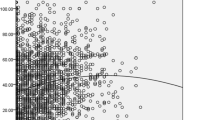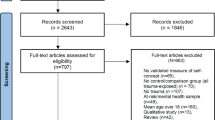Abstract
To examine the relationship between posttraumatic stress disorder (PTSD) and perceived self-efficacy (PSE), 98 Bosnian and Croatian refugees, ages 13–18, completed Bandura's Children's Multidimensional Scales of Perceived Self-Efficacy, which measure self-predicted social functioning in 9 areas. Through interviews, participants were categorized according to DSM–IV criteria as traumatized PTSD-positive, traumatized PTSD-negative, and nontraumatized. ANCOVAs showed PTSD-positive participants exhibit higher PSE than nontraumatized participants in 5 of 9 areas. No significant differences among 3 female groups were observed; however, nontraumatized boys demonstrated lower PSE than the 2 traumatized groups in 7 of 9 areas. Thus, PTSD did not have a negative impact on PSE in this cultural context. Furthermore, surviving traumatic experience and preserving social support networks may be protective factors for maintaining high levels of PSE.
Similar content being viewed by others
References
Ajdukovic, M., & Ajdukovic, D. (1993). Psychological well-being of children. Child Abuse and Neglect, 17, 843–854.
Allen, J. P., Leadbeater, B. J., & Aber, J. L. (1990). The relationship of adolescents' expectations and values to delinquency, hard drug use, and unprotected sexual intercourse. Development and Psychopathology, 2, 85–98.
American Psychiatric Association. (1994). Diagnostic and statistical manual of mental disorders (4th ed.). Washington, DC: Author.
Bandura, A. (1977). Self-efficacy: Toward a unifying theory of behavior change. Psychological Review, 84, 191–215.
Bandura, A. (1982). Self-efficacy mechanism in human agency. American Psychologist, 37, 122–147.
Bandura, A. (1986). Social foundations of thought and action: A social cognitive theory. Englewood Cliffs, NJ: Prentice-Hall.
Bandura, A. (1990a). Multidimensional scales of perceived self-efficacy. Unpublished manuscript, Stanford University.
Bandura, A. (1990b). Perceived self-efficacy in the exercise of control over AIDS infections. Evaluation and Program Planning, 13, 9–17.
Bandura, A., Barbaranelli, C., Caprara, G. V., & Pastorelli, C. (1996). Multifaceted impact of self-efficacy beliefs on academic functioning. Child Development, 67, 1206–1222.
Basen-Engquist, K. (1994). Evaluation of a theory-based HIV prevention intervention for college students. AIDS Education and Prevention, 6, 412–424.
Dubow, D. F., Schmidt, D., McBride, J., Edwards, S., & Merk, F. L. (1993). Teaching children to cope with stressful experiences: Initial implementation and evaluation of a primary prevention program. Journal of Clinical Child Psychology, 22, 428–440.
Foa, E. B., & Riggs, D. S. (1993). Posttraumatic stress disorder and rape. In J. M. Oldham, M. B. Riba, & A. Tasman (Eds.), Review of psychiatry (Vol. 12, pp. 272–303). Washington, DC: American Psychiatric Press.
Foa, E. B., Riggs, D. S., Dancu, C. V., & Rothbaum, B. O. (1993). Reliability and validity of a brief instrument for assessing posttraumatic stress disorder. Journal of Traumatic Stress, 6, 459–473.
Garbarino, J., & Kostelny, K. (1996). What do we need to know to understand children in war and community violence? In R. J. Apfel & B. Simon (Eds.), Minefields in their hearts: The mental health of children in war and communal violence (pp. 33–51). New Haven, CT: Yale University Press.
Gist, M. E., Stevens, C. K., & Bavetta, A. G. (1991). Effects of self-efficacy and posttraining intervention on the acquisition and maintenance of complex interpersonal skills. Personnel Psychology, 44, 837–861.
Grubbs, S., Hardin, S. B., Weinrich, S., Weinrich, M., Garrison, C., Pesut, D., & Hardin, T. L. (1992). Self-efficacy in normal adolescents. Issues in Mental Health Nursing, 13, 121–128.
Hobfoll, S. E., Briggs, S., & Wells, J. (1995). Community stress and resources: Actions and reactions. In S. E. Hobfoll & M. W. de Vries (Eds.), Extreme stress and communities: Impact and intervention (pp. 137–158). Dordrect, The Netherlands: Kluwer.
Kavanagh, D. J. (1992). Self-efficacy and depression. In R. Schwarzer (Ed.), Self-efficacy: Thought control of action (pp. 177–193). Washington, DC: Hemisphere.
Lyons, J. A. (1991). Strategies for assessing the potential for positive adjustment following trauma. Journal of Traumatic Stress, 4, 93–111.
Macksoud, M. S., Dyregrov, A., & Raundalen, M. (1993). Traumatic war experiences and their effects on children. In J. P. Wilson & B. Raphael (Eds.), International handbook of traumatic stress syndromes (pp. 625–633). New York: Plenum Press.
Martocchio, J. J. (1994). Effects of conceptions of ability on anxiety, self-efficacy, and learning in training. Journal of Applied Psychology, 79, 819–825.
McFarlane, A. H., Bellissimo, A., Norman, G. R., & Lange, P. (1994). Adolescent depression in a school-based community sample: Preliminary findings on contributing social factors. Journal of Youth and Adolescence, 23, 601–620.
Multon, K. D., Brown, S. D., & Lent, R. W. (1991). Relation of self-efficacy beliefs to academic outcomes: A meta-analytic investigation. Journal of Counseling Psychology, 38, 30–38.
Pynoos, R. S. (1993). Traumatic stress and developmental psychopathology in children and adolescents. In J. M. Oldham, M. B. Riba, & A. Tasman (Eds.), Review of psychiatry (Vol. 12, pp. 205–238). Washington, DC: American Psychiatric Press.
Pynoos, R. S., & Nader, K. (1993). Issues in the treatment of posttraumatic stress in children and adolescents. In J. P. Wilson & B. Raphael (Eds.), International handbook of traumatic stress syndromes (pp. 535–549). New York: Plenum Press.
Sack, W. H., Clarke, G. N., Kinney, R., Belestos, G., Him, C., & Seeley, J. (1995). The Khmer adolescent project: II. Functional capacities in two generations of Cambodian refugees. Journal of Nervous and Mental Disease, 183, 177–181.
Saigh, P. A., Mroueh, M., Zimmerman, B. J., & Fairbank, J. A. (1995). Self-efficacy expectations among traumatized adolescents. Behavior Research and Therapy, 33, 701–704.
Solomon, Z., Benbenishty, R., & Mikulincer, M. (1991). The contribution of wartime, prewar, and postwar factors to self-efficacy: A longitudinal study of combat stress reaction. Journal of Traumatic Stress, 4, 345–361.
Tran, T. V. (1993). Psychological traumas and depression in a sample of Vietnamese people in the United States. Health and Social Work, 18, 184–194.
Udwin, O. (1993). Annotation: Children's reactions to traumatic events. Journal of Child Psychology and Psychiatry, 34, 115–127.
van der Kolk, B. A., van der Hart, O., & Burbridge, J. (1995). The treatment of posttraumatic stress disorder. In: S. E. Hobfoll & M. W. de Vries (Eds.), Extreme stress and communities: Impact and intervention (pp. 421–443). Dordrect, The Netherlands: Kluwer.
van der Veer, G. (1993). Psychotherapy with young adult political refugees: A developmental approach. In J. P. Wilson & B. Raphael (Eds.), International handbook of traumatic stress syndromes (pp. 651–657). New York: Plenum Press.
Weine, S. M., Becker, D. F., McGlashan, T. H., Laub, D., Lazrove, S., Vojvoda, D., & Hyman, L. (1995a). Psychiatric consequences of “ethnic cleansing”: Clinical assessments and trauma testimonies of newly resettled Bosnian refugees. American Journal of Psychiatry, 152, 536–542.
Weine, S., Becker, D. F., McGlashan, T. H., Vojvoda, D., Hartman, S., & Robbins, J. P. (1995b). Adolescent survivors of “ethnic cleansing”: Observations on the first year in America. Journal of the American Academy of Child and Adolescent Psychiatry, 34, 1153–1159.
Weisenberg, M., Schwarzwald, J., & Solomon, Z. (1991). Effects of combat stress reaction and post-traumatic stress disorder on perceived self-efficacy in battle. Military Psychology, 3, 61–71.
Williams, S. L. (1995). Self-efficacy, anxiety, and phobic disorders. In J. E. Maddux (Ed.), Self-efficacy, adaptation, and adjustment: Theory, research, and application (pp. 69–107). Baltimore: The Johns Hopkins University Press.
Zimmerman, B. J., Bandura, A., & Martinez-Pons, M. (1992). Self-motivation for academic attainment: The role of self-efficacy beliefs and personal goal setting. American Educational Research Journal, 29, 663–676.
Zivcic, I. (1993). Emotional reactions of children to war and stress in Croatia. Journal of the American Academy of Child and Adolescent Psychiatry, 32, 709–713.
Author information
Authors and Affiliations
About this article
Cite this article
Ferren, P.M. Comparing Perceived Self-Efficacy Among Adolescent Bosnian and Croatian Refugees with and Without Posttraumatic Stress Disorder. J Trauma Stress 12, 405–420 (1999). https://doi.org/10.1023/A:1024749118463
Issue Date:
DOI: https://doi.org/10.1023/A:1024749118463




